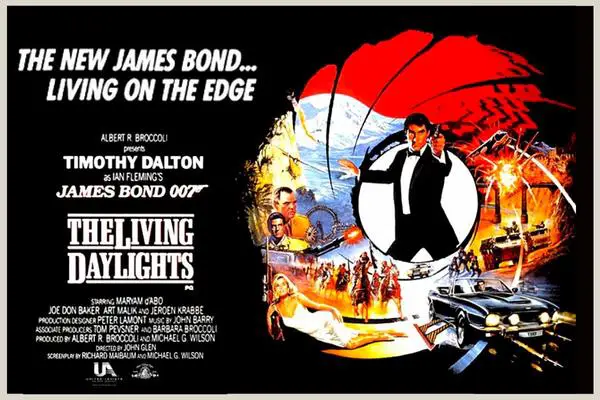The Living Daylights – A New Era for 007
The Living Daylights is the fifteenth James Bond film, released in 1987. The film stars Timothy Dalton as James Bond for the first time, and was a Box Office and critical success.
It was a new beginning for the Bond franchise in many ways after Dalton finally succeeded Roger Moore, who’d been 007 for the previous 7 films.
Not only did we have a new Bond, but we also had a new Miss Moneypenny, played by Caroline Bliss, after the original and longstanding Moneypenny actress, Lois Maxwell retired from the cast after almost 25 years in the role.
The plot is built on Ian Fleming’s short story of the same name, and revolves around Bond’s efforts to prevent a rogue Russian general from selling weapons to a terrorist organization.
Bond is sent to assassinate a would-be-assassin, but is set up. 007 smells a rat and investigates himself, which sees him travel through Czechoslovakia, Austria, Tunisia and Afghanistan as he uncovers the myriad of set ups.
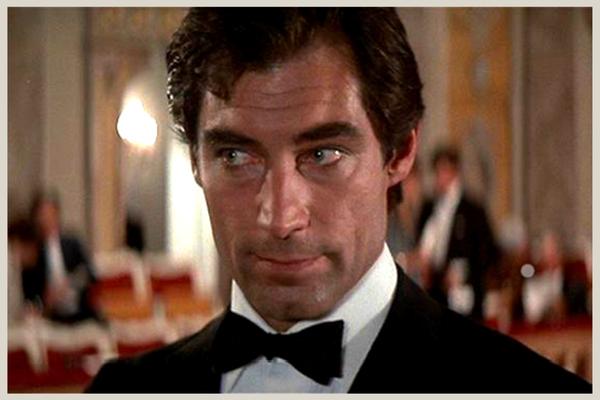
There’s a spectacular return of gadgets after they took a backseat during Moore’s reign and we also get to see Bond back driving the best cars on the planet, an Aston Martin V8, which is kitted out with some memorable gadgets.
The Living Daylights was a success all round, and in his first outing as the world’s favourite secret agent, Timothy Dalton really put his name down as Bond, James Bond.
Synopsis
The plot starts with Bond being assigned to assist in the defection of a KGB officer, General Koskov, who fears for his life. Bond is sent to Bratislava, Czechoslovakia to sniff out any snipers sent to kill Koskov as he leaves the concert hall.
Bond is in the concert getting the rundown from MI6 ally Saunders on Koskov, when he spots beautiful cellist, Kara Milovy on stage.
Later, when Bond is in position with his Walther WA 2000 sniper rifle, he spots a sniper in position to shoot Koskov. But the assassin is the beautiful, blond cellist, Kara, so Bond disobeys orders to kill, and shoots at her hand to put her off shooting Koskov.
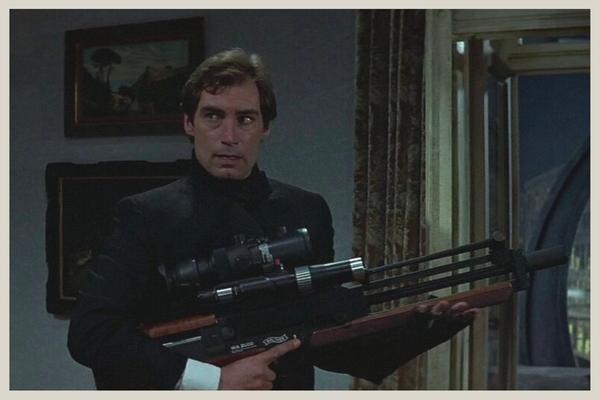
Koskov explains to Bond that an old KGB policy ‘Smiert Spionam’ (Death to Spies) is to be brought into legislation again by the new head of KGB General Leonid Pushkin. Bond then sends Koskov over the Austrian border using a gas pipeline.
Koskov is then sent to the UK, where he’s housed up in an MI6 safehouse. However, henchman Necros infiltrates the safehouse and kidnaps Koskov.
The kidnap turns out to be staged, however, as Necros is a henchman of Koskov. The rogue General has set up Bond and MI6 to try and get them to assassinate Pushkin, and is actually staying with Necros at American arms dealer Brad Whittaker’s place in Tangiers.
Bond is still unaware that he was set up, but returns to Bratislava to hunt down cellist Kara. She turns out to be Koskov’s love interest, so Bond tells her he’s on Koskov’s side and she should accompany him to Vienna to reunite with Koskov.
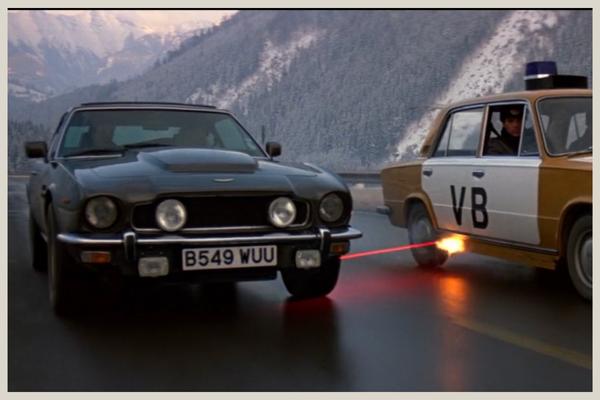
Bond expertly evades the KGB and gets Kara over the border and into Vienna, a place the expert cellist dreams of playing at. While there, Bond goes to Prater, a famous amusement park in Vienna to learn more of the investigation from Saunders, which confirms Bond’s suspicions of Koskov being a rogue.
After their meeting, Saunders walks out of the café and is killed by Necros, who leaves the message ‘Smiert Spionam’ at the scene, confirming Bond’s suspicions and understanding the murder was a warning for him from Koskov.
Bond heads to Tangiers and goes to Pushkins hotel suite to get information about the ‘Smiert Spionam’ policy, but Pushkin denies it and explains how Koskov has gone rogue and is trying to get Bond to kill Pushkin.
Bond then fakes Pushkins death as he shoots him at a public gathering to make Koskov think his plan is working. Kara then drugs Bond after Koskov tells her he’s actually KGB. Koskov and Necros then Take Bond and Kara on a plane headed for a Soviet base in Afghanistan.
Bond and Kara are to be thrown in a prison cell at the base, but Bond overcomes the guard with the help of his keyring gadget that Q had given him earlier. Bond then throws the keys to the imprisoned leader of the local Mujahideen, Kamran Shah, as he and Kara set to escape the Soviet Base.
Bond is then helped by the Mujahideen for helping release Shah. They help Bond, who’s now dressed as a local, to escape the compound. On route, Bond notices Koskov and Necros heading towards them. They’re there to purchase a large quantity of opium from the Mujahideen.
Bond helps load the cargo plane with the opium, and plants a bomb in the bags of opium. He’s spotted and has to lock himself inside the plane.
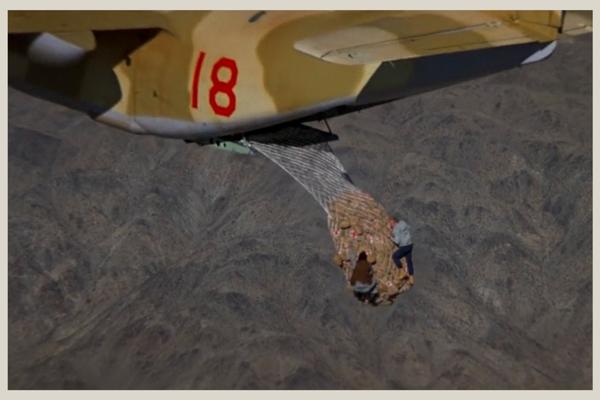
Fighting breaks out between the Mujahideen and the Soviets, and Bond starts the plane. As it’s about to take off Kara drives a jeep into the cargo deck, but Necros also gets onto the plane, too.
A big fight between Bond and Necros takes place on the bags of opium. The cargo hatch is opened and they end up fighting hundreds of feet in the air, while holding onto the netting. Bond gets the better of the giant hencman, who is holding onto Bond’s boot. Bond then cuts his boot open so it slides off and with it Necros falls to his death.
Bond then drops the bomb from the plane, landing it on a Soviet bridge, cutting off their route to the Mujahideen. The plane is just about to crash into the mountains as Bond prepares a daring escape in the Jeep.
Back on land, 007 then heads back to Tangiers and kills arms dealer Whitaker, and has Koskov arrested and handed over to Pushkin.
The film ends with Kara playing a world tour of all the best orchestral concert halls in the world. It’s her opening night and people are there to celebrate with her, but no Bond, so she thinks.
When she retires to her dressing room she walks in and there are 2 Martinis, shaken, not stirred, as she and 007 celebrate in private.
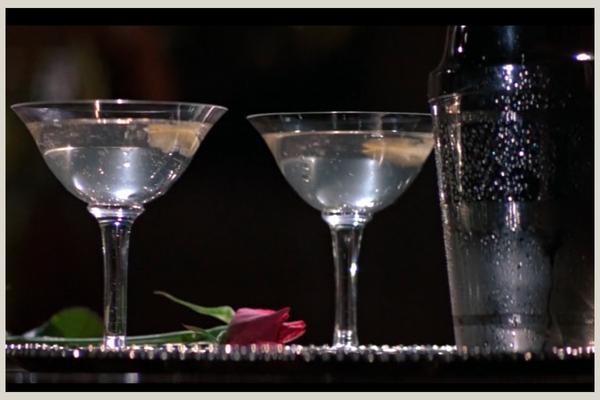
Timothy Dalton as Bond in The Living Daylights
After missing out on the Bond role on 3 previous occasions, Timothy Dalton signed a three-film contract in 1986 following Roger Moore hanging up his tuxedo.
Dalton completely changed up Bond with more realism and grit and was closer to the Bond in Ian Fleming’s novels, compared with Moore’s more light-hearted approach.
Dalton wasn’t keen on the approach taken during Moore’s reign and it’s why he turned down the role for Octopussy. So, with the new approach and a more realistic plot, it really worked.
The Living Daylights was a critical and commercial success for the James Bond franchise, due in large part to Timothy Dalton’s portrayal of the iconic spy. Though some may critiqued his stiff jaw, Dalton’s unique interpretation of the character and his commitment to staying true to the source material made a significant impact on the film’s success.
Dalton brings out the dangerous and intense nature of Bond with his piercing gaze, snarling expression, and total commitment to the role. Those qualities have ensured he lived up to the label of being the most dangerous man on earth.
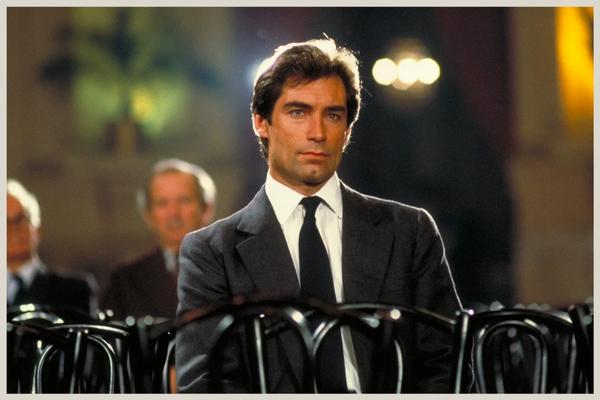
Dalton wanted to do all of his stunts, and although Broccoli was against it, knowing a stuntman could do better, he was allowed to perform many.
Although we see Bond woo a girl very early on, and ask for an extra hour after discovering she’s alone and keen on him, we see a more personal Bond, similar to George Lazenby‘s in On Her Majesty’s Secret Service.
The relationship he builds with cellist Kara Milovy is central to the plot, but of course being Bond, he had to stop the Ferris Wheel to spend some alone time with her.
Timothy Dalton’s portrayal of James Bond was particularly noteworthy in the film’s action sequences. From the opening training exercise to the high-speed car chase in Bratislava and the intense fight scene on the back of an airplane, Dalton brought a sense of realism to these scenes that elevated their impact.
All in all, it was a very successful move by the Bond production team. Dalton could have been Bond in the 1960s had he not thought he was too young, and then in the 1970s after refusing to take over the impressive Sean Connery. His time was finally right and his performance as 007 in The Living Daylights is definitely up there with the very best Bond films.
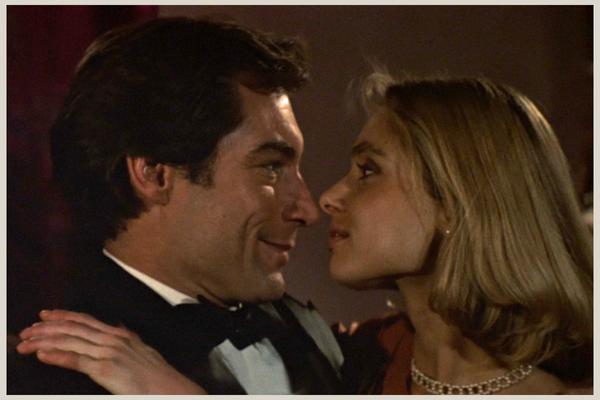
Bond Villains
Bond villains changed course in The Living Daylights. Gone is the megalomaniac with an unbelievable plan and technology to dominate the world, replaced by, well, not the most memorable villain.
That’s not to say Jeroen Krabbé as General Georgi Koskov and his henchman Necros, played by Andreas Wisniewski played a bad part, because they were good. Its just that Bond is supposed to come up against supervillains and a plot so unbelievable, it’s difficult to imagine him overcoming them.
General Koskov
Georgi Koskov is a complex and multi-faceted villain. A former Soviet General who’s turned to a life of deceit and manipulation, using his intelligence and cunning to play both sides of the Cold War for his own gain.
Though initially appearing as a nervous pawn caught in the larger political game, it soon becomes clear that Koskov is a masterful manipulator, who will stop at nothing to achieve his goals. He gets Bond involved in his game with the ultimate of getting the MI6 to kill his rival, General Pushkin
He is the partner of cellist, Kara Milovy, and lavishes her with gifts such as an antique Stradivarius cello, and uses his influence to get her into the best concert halls in Eastern Europe. At the same time, he sets her up and is about to be killed by Bond, until 007 smells a rat.
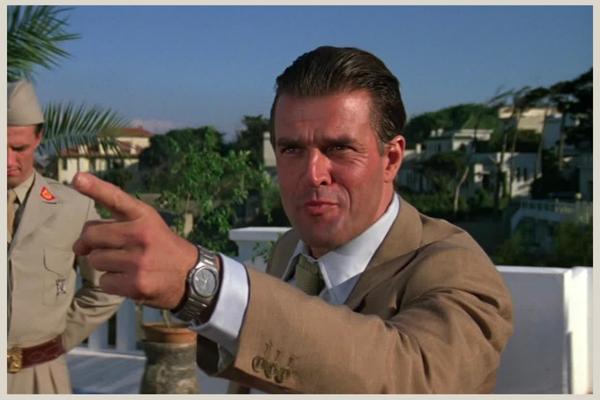
In the put up job, Bond is assigned to help him across the border into Austria and then to the UK. At a safe house in England, Koskov falsely accuses KGB head General Pushkin of a plot to kill American and British spies.
Later, Bond discovers that Koskov’s true plan was to purchase a massive supply of opium from Afghan drug lords and distribute it for personal profit while buying armaments to bolster the Soviet occupation of the country.
Bond, with the help of Kara and his Mujaheddin allies, disrupt the drug exchange, which ultimately leads to Koskov’s capture and arrest by the Russian government. It’s not the most epic plot or ending to a Bond villain, but it fits in very well with The Living Daylights plot and adds to the success of the film.
Necros
Necros is and international mercenary and former KGB agent, now employed by Koskov as his main henchman. Played by 6ft 5in German actor Andreas Wisniewski, Necros is typical of the henchmen Bond has come up against over the decades.
He’s tall and powerful, and very versatile, and is the main threat to Bond throughout the film. He assassinates Saunders, intends to assassinate General Pushkin until Bond stages his death, and is also the action man behind the capturing of Koskov from the MI6 safehouse.
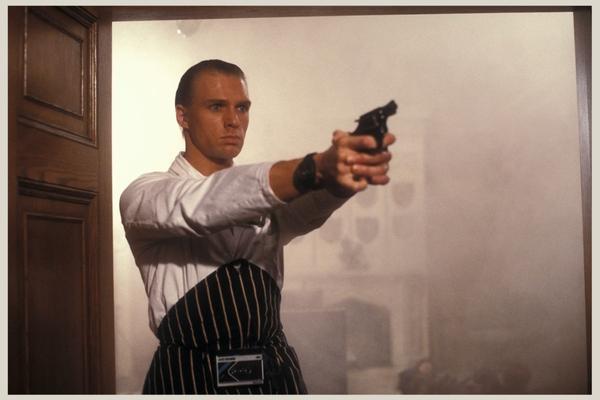
He’s everywhere danger is and he engages in a gripping and intense fight with Bond towards the end of the film. The fight takes place on a stack of opium hanging out of an airplane, with both men hanging on and trying to gain the upper hand. The fight reaches its climax when Necros is hanging onto Bond’s boot and 007, in a moment of quick thinking, cuts his own boot open causing Necros to fall to his death.
Bond Girls
Kara Milovy
Kara Milovy is a cellist from Czechoslovakia who’s dating former KGB General Georgi Koskov. She’s unaware of his true identity and involvement in illegal activities, and the first we and Bond see of her is on stage at an orchestra.
It’s her dream to play at Carnegie Hall and all the best concert halls throughout Europe, and it’s Koskov who’s used his influence to get her a place in the orchestra in Bratislava.
Bond is in Bratislava because he is to protect Koskov and snipe out any possible assassins he sees. Shockingly to Bond, he sees a sniper and it’s Kara, but instead of shooting her dead, he disobeys orders and shoots at her to put her off.
After Bond gets Koskov out of Czechoslovakia, he goes back to Kara’s to try and understand why a cellist was aiming to kill a former KGB General. He learns here that she’s Koskov’s girlfriend, so Bond promises her that he will reunite them if she goes with him.
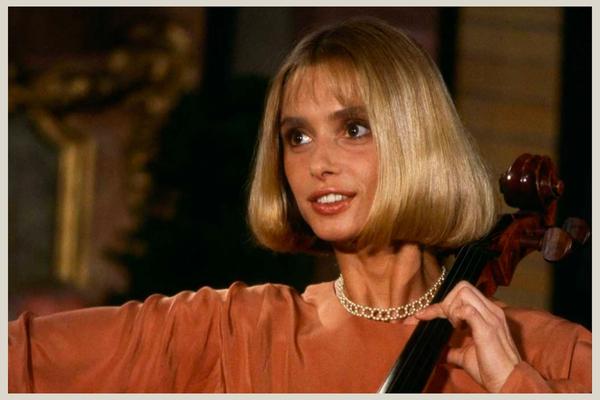
As the plot unfolds and the fact that Koskov has set both Bond and Kara up, the two of them develop a relationship, which is central to the plot.
Throughout the film, Kara’s character develops from a naive girlfriend to a strong-willed and independent woman, who can give as good as she gets.
After the plot has unfolded, the film ends with Kara celebrating the first night of her world tour, with her friends and family, but no 007.
As she retires to her dressing room, disappointed that James Bond isn’t there, she notices a bottle and 2 glasses of Martini, shaken not stirred of course, and the film ends with the two alone together.
Linda
Linda is only a minor character, but she is the first Bond girl in the Timothy Dalton era. Played by Belle Avery, Linda is in the opening scene on her own in a yacht off the coast of Gibraltar.
Venting her discontentment with the Mediterranean lifestyle, she bemoans the over abundance of “playboys” and “tennis pros”, telling her friend she hopes “I meet a real man”.
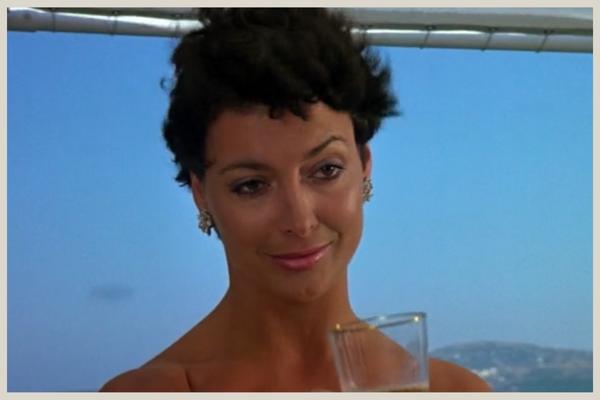
Just seconds later, James Bond parachutes onto the woman’s yacht and grabs her telephone to call Exercise Control. She asks who he is, and he tells her, “Bond, James Bond.”
On the phone Bond tells Exercise Control that he’ll report in one hour. As he says it, Linda offers him a champagne, asking if he’ll join her. So, Bond tells Exercise Control to make it 2 hours instead.
Best Scenes in the Living Daylights
Opening Scene
The Living Daylights opens with a group of “00” agents participating in a high-stakes paintball shooting training exercise over the Gibraltar, British base in the Mediterranean.
As the agents parachute from their aircraft, things quickly take a turn for the worse when an enemy agent infiltrates the exercise kills two agents, before stealing a Land Rover and driving off with a load of explosives in the back.
Bond hears the commotion and the Land Rover screeching away, and gives chase on foot. He’s high above the Land Rover and jumps down, landing on the canvas top.
Watch Timothy Dalton introduce himself as Bond in the opening scene of The Living Daylights
Bond then cuts through the canvas and fights to gain control of the Land Rover, and as the man driving it veers it off the Gibraltar rock and down towards the Mediterranean Sea.
Bond, being the resourceful agent that he is, manages to jump out of the vehicle and deploy his parachute in time, while the enemy agent isn’t so lucky as the Land Rover blows up before plunging into the sea.
Bond floats to a safe landing on a nearby yacht, where he is greeted by the bikini-clad socialite Linda, who has just been complaining that there are no real mean around these parts.
Bond tells her he needs her phone before she asks who he is. ‘Bond, James Bond’ replies 00, who reports to exercise control, saying he’ll be an hour. Linda duly hands him a glass of champagne, Bond pauses briefly before responding with a dry, “better make that two.”
This scene introduces us to Timothy Dalton as Bond and the action is exciting, the stunts are pretty much his own, and the way he introduces himself to Linda and the watching public for the first time as the suave Secret Agent is ultra-cool.
Czech Police Chase Bond
Bond manages to sneak Kara away from the watching KGB in his Aston Martin V8.
Their escape doesn’t go unnoticed and word quickly reaches the Czech police, who give chase. As the police cars close in on Bond and Kara, Bond uses a built in laser to detach the wheels from one of the police cars, causing the car to slide off its chassis and onto the road.
The other police then set up a roadblock, but Bond, utilizing the V8’s ‘optional extras,’ launches rockets from the car, blowing up the truck blocking their path and allowing them to continue their escape.
Bond and Kara are chased by Czech police
The chase continues as snow trucks and tanks are deployed by the police. The V8 is bulletproof, but as the pursuit leads them onto a frozen lake, one of the tires is blown out. With the V8 now driving on its metal rim, Bond uses the situation to his advantage and cuts a perfect circle with the police car in the middle, which sinks into the frozen lake.
As the police close in, Bond deploys the V8’s outriggers, using them to leverage an escape by speeding off over a ramp and to safety, and a following police car tries the same but smashes into a hut as 007 and Kara drive off.
Cars and Gadgets Used
The Living Daylights saw Bond reunited with an Aston Martin for the first time in 18 years, but this time with the V8 Vantage Volante model.
The Aston Martin V8 is a luxury sports car produced by Aston Martin from 1969 to 1989. The V8 in the film was powered by a 5.3-liter V8 engine that produced around 320 horsepower. This engine was paired with a four-speed manual transmission or a three-speed automatic transmission, depending on the model. The V8 had a top speed of around 160 mph, and could go from 0 to 60 mph in around 6 seconds.
The V8 was based on the Aston Martin DBS, which was produced from 1967 to 1972. The DBS was succeeded by the V8, which featured a number of updates, including a larger engine and a new design. The V8 was available in a number of different body styles, including a two-door coupe, a two-door convertible, and a four-door sedan.
The decision to feature the Aston Martin V8 Vantage in the film was made late into production, which presented challenges for the production team.
One of the main issues was obtaining the necessary vehicles for filming, as the V8 Vantage model was in high demand with an 18-month waiting list. To overcome this, the production team had to source and purchase three used Vantages for filming purposes.
The V8 Vantage, as driven by James Bond, is equipped with a variety of gadgets, such as lasers concealed in the front port and starboard wheel spinners that are capable of cutting through the chassis of any vehicle that pulls up alongside Bond, as the Czech police found out.
Another set of useful gadgets are the two forward-firing missiles hidden behind each of the front lights. These missiles can be armed and disarmed by switches concealed in the center armrest and their firing angle can be fine-tuned by an air vent slide-switch.
They’re controlled and aligned by a before-its-time heads up display (remember this was the 1980s), that projects targeting details such as target distance and elevation, car speed, time to target, safe distance, ambient temperature, and two adjustable targeting reticles onto the windshield.
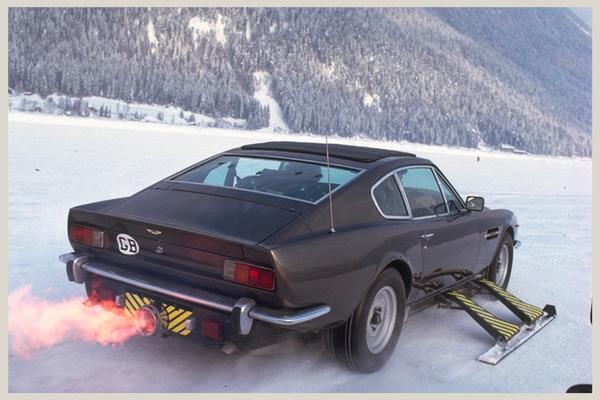
Other notable gadgets on the V8 Vantage include: retractable outriggers, retractable ice spikes embedded in the tires, a rocket booster, a radio scanner, a reinforced chassis, and a self-destruct mechanism.
It was 18 years since Bond was On Her Majesty’s Secret Service that we previously saw him in an Aston Martin, so this return to form for the British sport brand was memorable. The same car made a return in Daniel Craig‘s last outing No Time to Die, and one of the cars was sold at an auction in 2022, raising £630,000 for charity.
The Living Daylights – A New Era
The Living Daylights marked the beginning of a new era for the James Bond franchise. With Timothy Dalton in the lead role, this entry into the series featured gripping action sequences and complex character development that set a new standard for Bond films.
The film also introduced much more modern technology to the franchise, such as laser weaponry and digital surveillance systems, while still maintaining its classic feel.
After Roger Moore’s over-extended, frivolous stay as Bond, this new direction was more than welcome. As was Timothy Dalton as a new, more serious and exciting 007.
The Living Daylights set the stage for a new generation of Bond films and remains one of the favourite Bond films for many fans throughout the series’ legacy.


